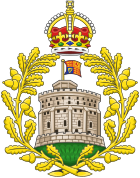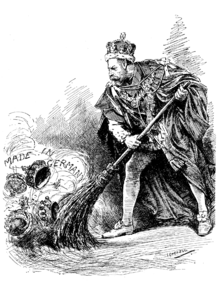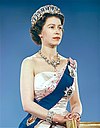German Family Name of the British Royal Family
| Business firm of Windsor | |
|---|---|
 Badge of the House of Windsor | |
| Parent business firm | Saxe-Coburg and Gotha (Cadet co-operative of Wettin) |
| Country | United Kingdom and other Commonwealth realms |
| Founded | 17 July 1917 (1917-07-17) |
| Founder | George 5 |
| Electric current caput | Elizabeth Ii |
| Members | Listing |
| Cadet branches | Mountbatten-Windsor (by cognatic descent) |
The House of Windsor is the reigning purple house of the United Kingdom and the other Commonwealth realms. In 1901, a line of the Firm of Saxe-Coburg and Gotha (itself a buck branch of the House of Wettin) succeeded the Firm of Hanover to the British monarchy with the accession of King Edward Seven, son of Queen Victoria and Prince Albert of Saxe-Coburg and Gotha. In 1917, the name of the British majestic house was changed from the High german Saxe-Coburg and Gotha to the English Windsor considering of anti-German sentiment in the United kingdom of great britain and northern ireland during World State of war I.[1] There take been four British monarchs of the House of Windsor since and then: George V, Edward VIII, George VI, and Elizabeth II.
The current head of the house is monarch of fifteen sovereign states. These are the United Kingdom (where they are based), Canada, Australia, New Zealand, Jamaica, the Bahamas, Grenada, Papua New Republic of guinea, Solomon Islands, Tuvalu, Saint Lucia, Saint Vincent and the Grenadines, Belize, Antigua and Barbuda, and Saint Kitts and Nevis. As well as these separate monarchies, there are also three Crown dependencies, fourteen British Overseas Territories and two associated states of New Zealand.
Groundwork [edit]

"A Good Riddance"; drawing from Punch, Vol. 152, 27 June 1917, commenting on the King'southward gild to relinquish all German titles held by members of his family unit
Edward VII and, in turn, his son, George V, were members of the German ducal House of Saxe-Coburg and Gotha by virtue of their descent from Albert, Prince Consort, husband of Queen Victoria, the last British monarch from the Firm of Hanover. High anti-High german sentiment among the people of the British Empire during World War I reached a height in March 1917, when the Gotha G.4, a heavy aircraft capable of crossing the English language Channel, began bombing London directly and became a household name. In the aforementioned yr, on 15 March, King George's offset cousin, Nicholas II, the Emperor of Russian federation, was forced to forsake, which raised the spectre of the eventual abolitionism of all the monarchies in Europe. The King and his family were finally persuaded to abandon all titles held under the German Crown and to alter German titles and house names to anglicised versions. Hence, on 17 July 1917, a royal proclamation issued past George V declared:
Now, therefore, Nosotros, out of Our Imperial Will and Authority, practise hereby declare and announce that as from the date of this Our Royal Proclamation Our Firm and Family shall be styled and known as the House and Family of Windsor, and that all the descendants in the male line of Our said Grandmother Queen Victoria who are subjects of these Realms, other than female descendants who may marry or may have married, shall carry the said Proper noun of Windsor....[2]
The name had a long association with monarchy in United kingdom, through the town of Windsor, Berkshire, and Windsor Castle; the link is alluded to in the Circular Tower of Windsor Castle beingness the footing of the badge of the Business firm of Windsor. It was suggested by Arthur Bigge, 1st Businesswoman Stamfordham.[three] Upon hearing that his cousin had inverse the proper noun of the British royal firm to Windsor and in reference to Shakespeare's The Merry Wives of Windsor, German language Emperor Wilhelm 2 remarked jokingly that he planned to run into "The Merry Wives of Saxe-Coburg-Gotha".[4]
George V also restricted the use of British princely titles to his nearest relations,[5] and in 1919, he stripped three of his German relations of their British titles and styles.[6]
List of monarchs [edit]
| Portrait | Name | Birth | Reign | Coronation | Spouse | Death | Claim |
|---|---|---|---|---|---|---|---|
 | George Five | three June 1865 Marlborough Business firm | half-dozen May 1910 – 20 January 1936[vii] (25 years, 260 days) | 22 June 1911 | Mary of Teck | twenty Jan 1936 Sandringham House (aged seventy years, 230 days) | Son of Edward Vii and Alexandra of Denmark |
| Edward Eight | 23 June 1894 White Social club, Richmond Park | xx January 1936 – xi December 1936 (10 months, 21 days) | Cancelled | Wallis Simpson | 28 May 1972 4 Route du Gnaw d'Entraînement (anile 77 years, 340 days) | Son of George V and Mary of Teck | |
 | George Vi | 14 Dec 1895 York Cottage | 11 Dec 1936 – vi February 1952 (15 years, 57 days) | 12 May 1937 | Elizabeth Bowes-Lyon | 6 February 1952 Sandringham Business firm (aged 56 years, 54 days) | Son of George V and Mary of Teck |
 | Elizabeth 2 | 21 April 1926 17 Bruton Street, Mayfair | 6 February 1952 – present (70 years, 25 days) | two June 1953 | Philip Mountbatten | Living (age 95 years, 316 days) | Girl of George VI and Elizabeth Bowes-Lyon |

Members [edit]

Members of the Business firm of Windsor on the balustrade of Buckingham Palace, xv June 2013. Left to right: Prince Richard, Duke of Gloucester; Lady Rose Gilman; Prince Michael of Kent; Princess Michael of Kent; Lady Louise Mountbatten-Windsor; Prince Edward, Earl of Wessex; James Mountbatten-Windsor, Viscount Severn; Sophie, Countess of Wessex; Camilla, Duchess of Cornwall; Prince Charles, Prince of Wales; Queen Elizabeth Ii; Princess Anne, Princess Royal; Prince Andrew, Knuckles of York; Prince Harry, Duke of Sussex; Catherine, Duchess of Cambridge; Prince William, Knuckles of Cambridge; Princess Eugenie; Princess Beatrice; Prince Edward, Duke of Kent; Katharine, Duchess of Kent
The 1917 proclamation stated that the name of the Royal House and all British descendants of Victoria and Albert in the male person line were to bear the name of Windsor, except for women who married into other families.
Descendants of Elizabeth Two [edit]
In 1947, Princess Elizabeth (now Queen Elizabeth II), heir presumptive to Male monarch George VI, married Philip Mountbatten (born Prince Philip of Greece and Denmark), a member of the House of Schleswig-Holstein-Sonderburg-Glücksburg, a branch of the House of Oldenburg. A few months before his wedlock, Philip abandoned his princely titles and adopted the surname Mountbatten, which was that of his uncle and mentor, the Earl Mountbatten of Burma, and had itself been adopted past Lord Mountbatten's father (Philip's maternal grandfather), Prince Louis of Battenberg, in 1917. It is the literal translation of the German Battenberg, which refers to Battenberg, a pocket-size boondocks in Hesse.
Soon afterwards Elizabeth became Queen in 1952, Lord Mountbatten observed that because it was the standard exercise for the married woman in a marriage to prefer her hubby's surname, the Firm of Mountbatten now reigned. When Elizabeth'southward grandmother, Queen Mary, heard of this comment, she informed British Prime Minister Winston Churchill and he afterwards advised the Queen to outcome a royal proclamation declaring that the majestic house was to remain known as the Firm of Windsor. This she did on 9 April 1952, officially declaring it her "Will and Pleasure that I and My children shall be styled and known as the House and Family unit of Windsor, and that My descendants, other than female descendants who ally and their descendants, shall bear the name of Windsor."[viii] Philip privately complained, "I am zilch but a encarmine amoeba. I am the only man in the state not allowed to requite his name to his own children."[9]
On 8 February 1960, some years later on both the expiry of Queen Mary and the resignation of Churchill, the Queen confirmed that she and her children would continue to be known as the "House and Family unit of Windsor", as would whatever agnatic descendants who enjoy the style of Royal Highness and the title of prince or princess.[8] Still, Elizabeth also decreed that her agnatic descendants who do non have that style and title would bear the surname Mountbatten-Windsor.[8]
This came after some months of correspondence between the Prime number Minister Harold Macmillan and the constitutional expert Edward Iwi. Iwi had raised the prospect that the royal child due to be born in Feb 1960 would bear "the Badge of Bastardy" if it were given its mother's maiden name (Windsor) rather than its male parent'due south name (Mountbatten). Macmillan had attempted to rebuff Iwi, until the Queen advised Rab Butler in January 1960 that for some time she had her heart attack a change that would recognise the name Mountbatten. She clearly wished to brand this change before the birth of her kid. The issue did not touch Prince Charles or Princess Anne, every bit they had been born with the name Mountbatten, before the Queen's accession to the throne.[10] Prince Andrew was born 11 days afterwards, on 19 February 1960.
Any future monarch tin change the dynastic proper name through a similar royal proclamation, as royal proclamations practice not have statutory authority.[11]
Family tree [edit]
- Red-framed persons are living
- Black-framed persons are deceased
- Bold borders indicate children of British monarchs
| Family tree of the House of Windsor | ||||||||||||||||||||||||||||||||||||||||||||||||||||||||||||||||||||||||||||||||||||||||||||||||||||||||||||||||||||||||||||||||||||||||||||||||||||||||||||||||||||||||||||||||||||||||||||||||||||||||||||||||||||||||||||||||||||||||||||||||||||||||||||||||||||||||||||||||||||||||||||||||||||||||||||||||||||||||||||||||||||||||||||||||||||||||||||||||||||||||||||||||||||||||||||||||||||||||||||||||||||||||||||||||||||||||||||||||||||||||||||||||||||||||||||||||||||||||||||||||||||||||||||||||||||||||||||||||||||||||||||||||||||||||||||||||||||||||||||||||||||||||||||||||||||||||||||||||||||||||||||||||||||||||||||||||||||||||||||||||||||||||||||||||||||||||||||||||||||||||||||||||||||||||||||||||||||||||||||||||||||||||||||||||||||||||||||||||||||||||||||||||||||||||||||||||||||||||||||||||||||||||||||||||||||||||||||||||||||||||||||||||||||||||||||||||||||||||||||||||||||||||||||||||||||||||||||||||||||||||||||||||||||||||||||||||||||||||||||||||||||||||||||||||||||||||||||||||||||||
|---|---|---|---|---|---|---|---|---|---|---|---|---|---|---|---|---|---|---|---|---|---|---|---|---|---|---|---|---|---|---|---|---|---|---|---|---|---|---|---|---|---|---|---|---|---|---|---|---|---|---|---|---|---|---|---|---|---|---|---|---|---|---|---|---|---|---|---|---|---|---|---|---|---|---|---|---|---|---|---|---|---|---|---|---|---|---|---|---|---|---|---|---|---|---|---|---|---|---|---|---|---|---|---|---|---|---|---|---|---|---|---|---|---|---|---|---|---|---|---|---|---|---|---|---|---|---|---|---|---|---|---|---|---|---|---|---|---|---|---|---|---|---|---|---|---|---|---|---|---|---|---|---|---|---|---|---|---|---|---|---|---|---|---|---|---|---|---|---|---|---|---|---|---|---|---|---|---|---|---|---|---|---|---|---|---|---|---|---|---|---|---|---|---|---|---|---|---|---|---|---|---|---|---|---|---|---|---|---|---|---|---|---|---|---|---|---|---|---|---|---|---|---|---|---|---|---|---|---|---|---|---|---|---|---|---|---|---|---|---|---|---|---|---|---|---|---|---|---|---|---|---|---|---|---|---|---|---|---|---|---|---|---|---|---|---|---|---|---|---|---|---|---|---|---|---|---|---|---|---|---|---|---|---|---|---|---|---|---|---|---|---|---|---|---|---|---|---|---|---|---|---|---|---|---|---|---|---|---|---|---|---|---|---|---|---|---|---|---|---|---|---|---|---|---|---|---|---|---|---|---|---|---|---|---|---|---|---|---|---|---|---|---|---|---|---|---|---|---|---|---|---|---|---|---|---|---|---|---|---|---|---|---|---|---|---|---|---|---|---|---|---|---|---|---|---|---|---|---|---|---|---|---|---|---|---|---|---|---|---|---|---|---|---|---|---|---|---|---|---|---|---|---|---|---|---|---|---|---|---|---|---|---|---|---|---|---|---|---|---|---|---|---|---|---|---|---|---|---|---|---|---|---|---|---|---|---|---|---|---|---|---|---|---|---|---|---|---|---|---|---|---|---|---|---|---|---|---|---|---|---|---|---|---|---|---|---|---|---|---|---|---|---|---|---|---|---|---|---|---|---|---|---|---|---|---|---|---|---|---|---|---|---|---|---|---|---|---|---|---|---|---|---|---|---|---|---|---|---|---|---|---|---|---|---|---|---|---|---|---|---|---|---|---|---|---|---|---|---|---|---|---|---|---|---|---|---|---|---|---|---|---|---|---|---|---|---|---|---|---|---|---|---|---|---|---|---|---|---|---|---|---|---|---|---|---|---|---|---|---|---|---|---|---|---|---|---|---|---|---|---|---|---|---|---|---|---|---|---|---|---|---|---|---|---|---|---|---|---|---|---|---|---|---|---|---|---|---|---|---|---|---|---|---|---|---|---|---|---|---|---|---|---|---|---|---|---|---|---|---|---|---|---|---|---|---|---|---|---|---|---|---|---|---|---|---|---|---|---|---|---|---|---|---|---|---|---|---|---|---|---|---|---|---|---|---|---|---|---|---|---|---|---|---|---|---|---|---|---|---|---|---|---|---|---|---|---|---|---|---|---|---|---|---|---|---|---|---|---|---|---|---|---|---|---|---|---|---|---|---|---|---|---|---|---|---|---|---|---|---|---|---|---|---|---|---|---|---|---|---|---|---|---|---|---|---|---|---|---|---|---|---|---|---|---|---|---|---|---|---|---|---|---|---|---|---|---|---|---|---|---|---|---|---|---|---|---|---|---|---|---|---|---|---|---|---|---|---|---|---|---|---|---|---|---|---|---|---|---|---|---|---|---|---|---|---|---|---|---|---|---|---|---|---|---|---|---|---|---|---|---|---|---|---|---|---|---|---|---|---|---|---|---|---|---|---|---|---|---|---|---|---|---|---|---|---|---|---|---|---|---|---|---|---|---|---|---|---|---|---|---|---|---|---|---|---|---|---|---|---|---|---|---|---|---|---|---|---|---|---|---|---|---|---|---|---|---|---|---|---|---|---|---|---|---|---|---|---|---|---|---|---|---|---|---|---|---|---|---|---|---|---|---|---|---|---|---|---|---|---|---|---|---|---|---|---|---|---|---|---|---|---|---|---|---|---|---|---|---|---|---|---|---|---|---|---|---|---|---|---|---|---|---|---|---|---|---|---|---|---|---|---|---|---|---|---|---|---|---|---|---|---|---|---|---|---|---|---|---|---|---|---|---|---|---|---|---|---|---|---|---|---|---|---|---|---|---|---|---|---|---|---|---|---|---|---|---|---|---|
| ||||||||||||||||||||||||||||||||||||||||||||||||||||||||||||||||||||||||||||||||||||||||||||||||||||||||||||||||||||||||||||||||||||||||||||||||||||||||||||||||||||||||||||||||||||||||||||||||||||||||||||||||||||||||||||||||||||||||||||||||||||||||||||||||||||||||||||||||||||||||||||||||||||||||||||||||||||||||||||||||||||||||||||||||||||||||||||||||||||||||||||||||||||||||||||||||||||||||||||||||||||||||||||||||||||||||||||||||||||||||||||||||||||||||||||||||||||||||||||||||||||||||||||||||||||||||||||||||||||||||||||||||||||||||||||||||||||||||||||||||||||||||||||||||||||||||||||||||||||||||||||||||||||||||||||||||||||||||||||||||||||||||||||||||||||||||||||||||||||||||||||||||||||||||||||||||||||||||||||||||||||||||||||||||||||||||||||||||||||||||||||||||||||||||||||||||||||||||||||||||||||||||||||||||||||||||||||||||||||||||||||||||||||||||||||||||||||||||||||||||||||||||||||||||||||||||||||||||||||||||||||||||||||||||||||||||||||||||||||||||||||||||||||||||||||||||||||||||||||||
States reigned over [edit]
At the cosmos of the House of Windsor, its head reigned over the British Empire. Following the end of the Kickoff World State of war, however, shifts took place that saw the emergence of the Dominions of the British Commonwealth as independent states. The shift was recognised in the Balfour Declaration of 1926,[12] [13] the Royal and Parliamentary Titles Act 1927,[14] [15] and the Statute of Westminster 1931.[16] [17] The Windsors became recognised as the royal family of multiple contained countries, a number that shifted over the decades, every bit some Dominions became republics and Crown colonies became realms, republics, or monarchies under a different sovereign.[18] Since 1949, two monarchs of the Business firm of Windsor, George Vi and Elizabeth Ii, have too been Head of the Commonwealth of Nations, comprising near (simply not all) parts of the former British Empire and some states that were never part of it.[19] [20] [21]
| State | Dates |
|---|---|
| Antigua and Barbuda | 1981–nowadays |
| Australia | 1917–present |
| Bahamas | 1973–present |
| Barbados | 1966–2021 |
| Belize | 1981–present |
| Canada | 1917–present |
| Ceylon | 1948–1972 |
| Fiji | 1970–1987 |
| The The gambia | 1965–1970 |
| Republic of ghana | 1957–1960 |
| Grenada | 1974–present |
| Republic of guyana | 1966–1970 |
| Republic of india | 1947–1950 |
| Irish Free State | 1922–1949 |
| Jamaica | 1962–present |
| Malawi | 1964–1966 |
| Malta | 1964–1974 |
| Mauritius | 1968–1992 |
| New Zealand | 1917–present |
| Nigeria | 1960–1963 |
| Rule of Pakistan | 1947–1956 |
| Papua New Guinea | 1975–present |
| Saint Kitts and Nevis | 1983–present |
| Saint Lucia | 1979–present |
| Saint Vincent and the Grenadines | 1979–present |
| Sierra Leone | 1961–1971 |
| Solomon Islands | 1978–present |
| S Africa | 1917–1961 |
| Tanganyika | 1961–1962 |
| Trinidad and Tobago | 1962–1976 |
| Tuvalu | 1978–nowadays |
| Republic of uganda | 1962–1963 |
| Britain | 1917–present |
See also [edit]
- British prince
- British princess
- Descendants of George V
- Succession to the British throne
Notes [edit]
- ^ After his abdication in 1936, King Edward VIII became the Duke of Windsor.
References [edit]
- ^ McGuigan, Jim (2001). "British identity and 'people's princess'". The Sociological Review. 48 (1): one–18. doi:10.1111/1467-954X.00200. S2CID 144119572.
- ^ "No. 30186". The London Gazette. 17 July 1917. p. 7119.
- ^ "How did the royal family choose the name 'Windsor'?". History Extra. Immediate Media Company. 28 April 2021. Retrieved 10 June 2021.
- ^ Carter, Miranda (2010), George, Nicholas and Wilhelm: Iii Royal Cousins and the Road to Earth War I, Random House, p. xxiii, ISBN9780307593023
- ^ "Styles of the members of the British regal family: Documents". Heraldica. 30 November 1917.
- ^ "At the Court at Buckingham Palace, the 28th day of March, 1919". London Gazette. His Majesty's Stationery Office. 28 March 1919. p. 4000.
- ^ George V was a member of the House of Saxe-Coburg and Gotha until he changed the name of the regal firm to Windsor on 17 July 1917.
- ^ a b c "Royal Styles and Titles of U.k.: Documents". www.heraldica.org. Archived from the original on 23 April 2016.
- ^ Brandreth, Gyles (2004). Philip and Elizabeth: Portrait of a Marriage. p.253–254. London: Century. ISBN 0-7126-6103-four
- ^ Travis, Alan (eighteen Feb 1999). "Queen feared 'slur' on family", The Guardian Archived 3 March 2016 at the Wayback Auto. Retrieved 17 April 2014
- ^ The Royal Family unit proper name Archived 30 May 2016 at the Wayback Machine, Royal Household, retrieved 24 Apr 2016
- ^ "Clause Two" (PDF).
- ^ "Balfour Study | Great britain [1926]". Encyclopedia Britannica.
- ^ "Regal and Parliamentary Titles Act 1927".
- ^ "The Government of Great Britain and the Dominions and Colonies", Albert Edmond Hogan, Isabell Gladys Powell, Harold Plaskitt, D.M. Glew, University tutorial Printing Limited, p. 238, 1939
- ^ "Statute of Westminster, 1931, 22 Geo. Five, c. 4, south. iv" (PDF).
- ^ "Statute of Westminster | Britain [1931]". Encyclopedia Britannica.
- ^ "The Monarchy Today > Queen and Commonwealth > Commonwealth Members". 29 February 2012. Archived from the original on 29 Feb 2012.
- ^ "Commonwealth (general)". The Royal Family unit. eleven March 2016.
- ^ "London Declaration". The Republic. 16 May 2019.
- ^ Hardman, Robert (2018), Queen of the Globe, Random Business firm, ISBN9781473549647 [ page needed ]
Bibliography [edit]
- Longford, Elizabeth Harman (Countess of Longford). The Royal House of Windsor. Revised ed. Crown, 1984.
- Roberts, Andrew. The House of Windsor. University of California Press, 2000.
External links [edit]
- Royal Family proper noun from purple.uk
- Business firm of Windsor from majestic.uk
- House of Windsor Tree from royal.gov.u.k. (Lord Culloden & Albert+Leopold Windsor are missing)
Source: https://en.wikipedia.org/wiki/House_of_Windsor
0 Response to "German Family Name of the British Royal Family"
Post a Comment